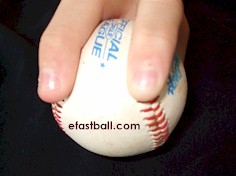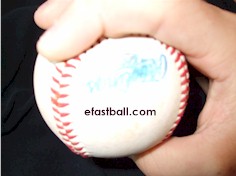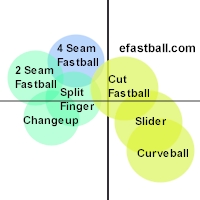
How to Grip a Two Seam Fastball
Updates:
- 5/08 - Initial page



2 Seam Fastball

Right Handed Pitcher
AKA
Since this 2 seamer pitch moves, this grip is also called a sinker, sinking fastball, or a tailing fastball. (All balls drop, but sinkers tend to drop more, and tailing fastballs go more sideways.)May also be referred to as a fastball or other four seam pitch names like smoker, hummer, cheese, or heater, etc.
A cutter is similar to a two seamer, but see our Cutter Grip page for details on how to grip and use this hybrid pitch.
Position the Ball
2 seam direction Turn the ball where the seams run the direction of your fingers and are closest together. The closed end of the horseshoes (the "U") are pointed up.Position your fingers
Place your index and middle fingers (first two fingers) inside (and lay next to) the two seams.Position your thumb
Place your thumb directly under the ball on the smooth part of the baseball (no seam).Exert Pressure
Get a good grip on the inside of the seams with your finger pads.Squeeze the ball with your thumb pushing against both your index and middle fingers.
Delivery and Release
Push your middle finger toward the batter. Your hand will pronate (thumb down, inward, clockwise LH, counterclockwise RH) slightly.This release is the same as a four seam fastball, and the opposite rotation of a curveball.
Compared to other grips
This is similar to the four seam fastball and is one of the fastest pitches, however, the 2 seamer has more movement and may be slightly harder to control. Where the four-seamer has four cross seams cutting against the air, the 2 seamer has only two.What the hitter sees
The two seams appear to the hitter as two near-vertical lines. So this pitch may be one of the easiest for the hitter to pick up on.However, a 2 seamer moves down and in slightly more than the average hitter expects.
Alternate grip
Rotate the ball forward to a cross seam and put the same two fingers over the horseshoe seam. Also, can rotate the ball forward to the next horseshoe cross seam.When to throw
This is one of the most common pitches thrown in baseball. It is slightly difficult to locate.This pitch is good to throw low in the strike zone. Since it moves down more than expected, this pitch will tend to induce ground outs.
What it does (movement)
The ball will move down and to the right for a right handed pitcher. For a left hand pitcher, it moves down and to the left.The ball creates a tight backspin and rotates from bottom-to-top as viewed by the hitter. It rotates slightly off-center and therefore may drop or move 4 to 6 inches.
Reaction Time
The hitter has roughly 0.40 seconds to hit this pitch.Typical Speed
This pitch is roughly the same speed as the four seam fastball which is the fastest pitch of all.| 10 and under | 40-50 mph |
| 11-12 | 50-60 mph |
| 13-14 | 55-75 mph |
| High School | 75-85 mph |
| College/ Pro | 80-95 mph |
The average speed of all fastballs in the majors is 91 mph.
The ball will typically slow down 8-10 mph by the time it reaches the front of the plate. (Note that your home radar gun may stop reading well before the ball reaches the plate because the hitter is in the way.)
